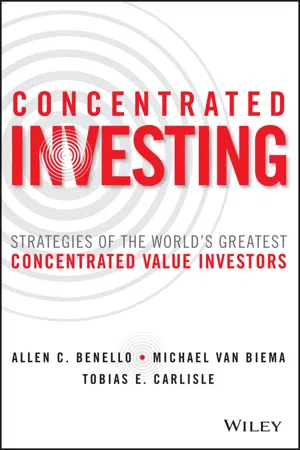
Concentrated Investing
Strategies of the World's Greatest Concentrated Value Investors
- English
- ePUB (mobile friendly)
- Available on iOS & Android
Concentrated Investing
Strategies of the World's Greatest Concentrated Value Investors
About this book
Discover the secrets of the world's top concentrated value investors
Concentrated Investing: Strategies of the World's Greatest Concentrated Value Investors chronicles the virtually unknown—but wildly successful—value investors who have regularly and spectacularly blown away the results of even the world's top fund managers. Sharing the insights of these top value investors, expert authors Allen Benello, Michael van Biema, and Tobias Carlisle unveil the strategies that make concentrated value investing incredibly profitable, while at the same time showing how to mitigate risk over time. Highlighting the history and approaches of four top value investors, the authors tell the fascinating story of the investors who dare to tread where few others have, and the wildly-successful track records that have resulted.
Turning the notion of diversification on its head, concentrated value investors pick a small group of undervalued stocks and hold onto them through even the lean years. The approach has been championed by Warren Buffett, the best known value investor of our time, but a small group of lesser-known investors has also used this approach to achieve outstanding returns.
- Discover the success of Lou Simpson, a former GEICO investment manager and eventual successor to Warren Buffett at Berkshire Hathaway
- Read about Kristian Siem, described as "Norway's Warren Buffett, " and the success he has had at Siem Industries
Concentrated Investing will quickly have you re-thinking the conventional wisdom related to diversification and learning from the top concentrated value investors the world has never heard of.
Frequently asked questions
- Essential is ideal for learners and professionals who enjoy exploring a wide range of subjects. Access the Essential Library with 800,000+ trusted titles and best-sellers across business, personal growth, and the humanities. Includes unlimited reading time and Standard Read Aloud voice.
- Complete: Perfect for advanced learners and researchers needing full, unrestricted access. Unlock 1.4M+ books across hundreds of subjects, including academic and specialized titles. The Complete Plan also includes advanced features like Premium Read Aloud and Research Assistant.
Please note we cannot support devices running on iOS 13 and Android 7 or earlier. Learn more about using the app.
Information
CHAPTER 1
Lou Simpson: The Disciplined Investor: A Portrait of Concentration
Stop the music.—Warren Buffett to Jack Byrne, chairman of GEICO, after meeting Lou Simpson in 19791
“Unstoppable” GEICO
Table of contents
- Cover
- Title page
- Copyright
- Dedication
- Preface
- Acknowledgments
- Introduction
- Chapter 1 Lou Simpson: The Disciplined Investor: A Portrait of Concentration
- Chapter 2 John Maynard Keynes: Investor Philosopher: The Economics of Concentration
- Chapter 3 Kelly, Shannon, and Thorp: Mathematical Investors: Concentration Quantified
- Chapter 4 Warren Buffett: The Kelly-Betting Value Investor: Portfolio Concentration for Value Investors
- Chapter 5 Charlie Munger: Concentration’s Muse: Quality without Compromise
- Chapter 6 Kristian Siem: The Industrialist: The Importance of Permanent Capital to the Long-Term Investor
- Chapter 7 Grinnell College: The School of Concentration: Concentration and Long-Term Investing for Endowment
- Chapter 8 Glenn Greenberg: The Iconoclast: Simple, Common Sense Research, and Tennis Shoes
- Chapter 9 Conclusion: The Concentrated Investor’s Temperament
- About the Authors
- Index
- EULA